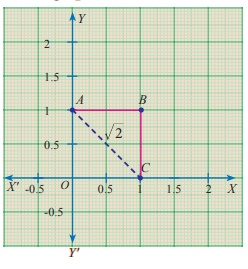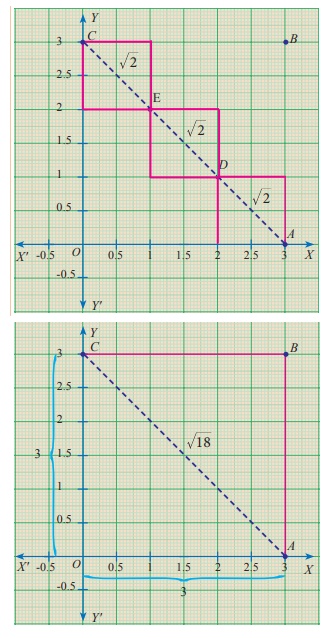Example Solved Problems | Real Numbers | Maths - Surds | 9th Maths : UNIT 2 : Real Numbers
Chapter: 9th Maths : UNIT 2 : Real Numbers
Surds
Surds
Having
familiarized with the concept of Real numbers, representing them on the number line
and manipulating them, we now learn about surds, a distinctive way of representing
certain approximate values.
Can
you simplify √4 and remove √ the symbol? Yes; one can replace √4 by the number 2. How about √[1/9] ? It is easy; without
√ symbol, the answer is 1/3. What about √0. 01 ?. This is also easy and the solution
is0.1
In
the cases of √4 , √[1/9] and √0. 01 , you can resolve to get a solution and make
sure that the symbol √ is not seen in your solution. Is this possible at all times?
Consider
√18. Can you evaluate it and also remove the radical symbol? Surds are unresolved
radicals, such as square root of 2, cube root of 5, etc.
They
are irrational roots of equations with rational coefficients.
A surd is an irrational root of a rational number. n√a
is a surd, provided n ∈ ℕ, n > 1, ‘a’ is rational.
Examples :
√2 is a surd. It is an irrational
root of the equation x2 = 2. (Note that x2 – 2 = 0 is an
equation with rational coefficients. √2 is irrational and may be shown as 1.4142135…
a non-recurring, non-terminating decimal).
3√3 (which is same as 31/3)
is a surd since it is an irrational root of the equation x3 – 3 = 0. (√3 is irrational and may be shown as 1.7320508…
a non-recurring, non-terminating decimal).
You
will learn solving (quadratic) equations like x2 – 6x + 7 = 0
in your next class. This is an equation with rational coefficients and one of its
roots is 3 + √2 , which is a surd.
Is
√[1/25] a surd? No; it can be simplified and written as rational number 1/5. How
about 4√[16/81] ? It is not a surd because it can be simplified as 2/3.
The
famous irrational number π is not a surd! Though it is irrational, it cannot be
expressed as a rational number under the √ symbol. (In other words, it is not a
root of any equation with rational co-efficients).
Why
surds are important? For calculation purposes we assume approximate value as √2
= 1.414 , √3 = 1.732 and so on.
(√2)2 = (1.414)2 = 1.99936
≠ 2 ; (√3)2 = (1.732)2 = 3.999824 ≠ 3
Hence,
we observe that √2 and √3 represent the more accurate and precise values than their
assumed values. Engineers and scientists need more accurate values while constructing
the bridges and for architectural works. Thus it becomes essential to learn surds.
Progress Check
1. Which is the odd one out? Justify your answer.
(i) √36, √(50/98), √1,
√1.44, 5√32, √120
(ii) √7, √48, 3√36, √5 + √3, √1.21, √(1/10)
2. Are all surds irrational numbers? − Discuss with your answer.
3. Are all irrational numbers surds? Verify with some examples.
1. Order of a Surd
The
order of a surd is the index of the root to be
extracted. The order of the surd n√a is n. What is the order of 5√99 ? It is
5.
Surds
can be classified in different ways:
(i)
Surds of same order : Surds of same order
are surds for which the index of the
root to be extracted is same. (They are also called equiradical
surds).
For example, √x , a3/2 , 2√m
are all 2nd order (called quadratic)
surds .
3√5 , 3√(x -2), (ab)1/3 are all 3rd
order (called cubic) surds.
√3 , 3√10,
4√6 and 82/5 are
surds of different order.
(ii)
Simplest form of a surd : A surd
is said to be in simplest form, when it is expressed as the product of a
rational factor and an irrational factor. In this form the surd has
(a)
the smallest possible index of the radical sign.
(b)
no fraction under the radical sign.
(c)
no factor is of the form an, where a is a positive integer
under index n.
Example 2.18
Can
you reduce the following numbers to surds of same order :
(i)
√3 (ii) 4√3 (iii) 3√3
Solution
(i)
√3= 31/2
=
36/12
=
12√36
=
12√729
(ii)
4√3 = 31/4
=
33/12
=
12√33
=
12√27
(iii)
3√3 = 31/3
=
34/12
=
12√34
= 12√81
The
last row has surds of same order.
Example 2.19
1.
Express the surds in the simplest form: i) √8
ii) 3√192
2.
Show that 3√7 > 4√5 .
Solution
1.
(i) √8 = √[4×2] = 2√2
(ii)
3√192 = 3√[4×4×4×3]
= 43√3
2.
3√7 =12√74 = 12√2401
4√5 = 51/4 = 53/12
= 12√53 =12√125
12√2401 > 12√125
Therefore,
3√7 > 4√5 .
(iii)
Pure and Mixed Surds : A surd
is called a pure surd if its coefficient
in its simplest form is 1. For example, √3 , 3√6 , 4√7 , 5√49 are pure
surds. A surd is called a mixed surd if its co-efficient
in its simplest form is other than 1. For example, 5√3 , 2 4√5 , 3 4√6
are mixed surds.
(iv)
Simple and Compound Surds : A
surd with a single term is said to be a simple
surd. For example, √3 ,
2√5 are simple surds. The algebraic sum of two (or more) surds is called a compound surd. For example, √5 +
3√2, √3 −2√7,
√5 −
7√2 +
6√3 are compound surds.
(v)
Binomial Surd : A binomial surd is an algebraic sum (or difference)
of 2 terms both of which could be surds or one could be a rational
number and another a surd. For example, 1/2 − √19, 5 + 3√2 , √3 − 2√7 are binomial
surds.
Example 2.20
Arrange
in ascending order: 3√2 , 2√4, 4√3
Solution
The
order of the surds 3√2 , 2√4 and 4√3 are 3, 2,4.
L.C.M.
of 3, 2, 4 = 12.

The
ascending order of the surds 3√2, 4√3, 2√4 is 12√16
< 12√27 < 12√4096 that is, 3√2, 4√3,
2√4.
2. Laws of Radicals
For
positive integers m, n and positive rational numbers a and
b, it is worth remembering the following properties of radicals:

We
shall now discuss certain problems which require the laws of radicals for simplifying.
Example 2.21
Express
each of the following surds in its simplest form (i) 3√108 (ii) 3√
(1024)−2 and find its order, radicand and coefficient.
Solution

order= 3 ; radicand = 1/4 ; coefficient = 1/64
(These
results can also be obtained using index notation).
Note
Consider the numbers 5 and 6. As 5 = √25 and 6 = √36
Therefore, √26, √27, √28, √29, √30, √31, √32, √33, √34, and √35 are surds between 5 and 6.
Consider 3√2 = √[32×2] = √18, 2√3= √[22×3]= √12
Therefore, √17, √15, √14, √13 are surds between 2√3 and 3√2.
3. Four Basic Operations on Surds
(i) Addition and subtraction of surds
: Like
surds can be added and subtracted using the following rules:
an√b
±
cn√b = (a ± c )n√b , where b >
0.
Example 2.22
(i) Add 3√7 and 5√7 . Check whether
the sum is rational or irrational. (ii) Subtract 4√5 from 7√5 . Is
the answer rational or irrational?
Solution
(i) 3√7+5√7 =(3+5) √7 = 8√7
. The answer is irrational.
(ii) 7√5 − 4√5 =(7−4) √5 =
3√5 . The answer is irrational.
Example 2.23
Simplify
the following:
(i)
√63− √175+ √28 (ii) 23√40 + 3 3√625
− 4 3√320
Solution
(i) √63−
√175+ √28 = √[9×7] – √ [25 ×7] + √ [4×7]
= 3√7−5√7+2√7
=
(3√7 +2√7) − 5√7
=
5√7−5√7
=
0
(ii)
23√40+33√625−43√320
=
23√[8×5]
+ 33√[125×5] −43√[64×5]
=
23√[23×5]
+33√[53×5]−43√[43×5]
=
2×23√5 + 3×53√5−4×43√5
=
43√5+153√5−163√5
= (4+15−16)3√5 = 33√5
(ii) Multiplication and division of surds
Like
surds can be multiplied or divided by using the following rules:

Example 2.24
Multiply
3√40 and 3√16 .
Solution
3√40 × 3√16 = (3√[2×2×2×5] ) × (3√[2×2×2×2])
= (2× 3√5)×(2× 3√2) =
4×(3√2 ×3√5)
= 4×3√[2×5]
= 43√10
Example 2.25
Compute
and give the answer in the simplest form: 2√72 × 5√32×3√50
Solution
2√72×5√32 × 3√50 = (2×6√2)× (5×4√2)× (3×5√2)
=
2×5×3×6×4×5× √2× √2× √2
=
3600×2√2
=
7200√2
Let us simplify:
√72 = √[36×2] =6√2
√32 = √[16×2]=4√2
√50 = √[25×2] =5√2
Example 2.26
Divide 9√8 by 6√6 .
Solution

Activity – 1
Is it interesting to see this pattern ?

Verify it. Can you frame 4 such new surds?
Solution:

Activity – 2
Take a graph sheet and mark O, A, B, C
as follows.

In the square OABC,
OA = AB = BC = OC = 1unit
Consider right angled DOAC
AC = √[12
+12]
= √2 unit [By Pythagoras
theorem]
The length of the diagonal
(hypotenuse)
AC = √2 , which is a surd.
Consider the following graphs:

Let us try to find the length of AC in two different ways :
AC = AD +DE +EC
(diagonals of units squares)
= √2+√2+√2
AC = 3√2 units
AC = √[OA2 +OC2]
= √[32 +32]
= √[9 + 9 ]
AC = √18 units
Are they equal? Discuss. Can you verify the same by taking different
squares of different lengths?
Solution:

Related Topics